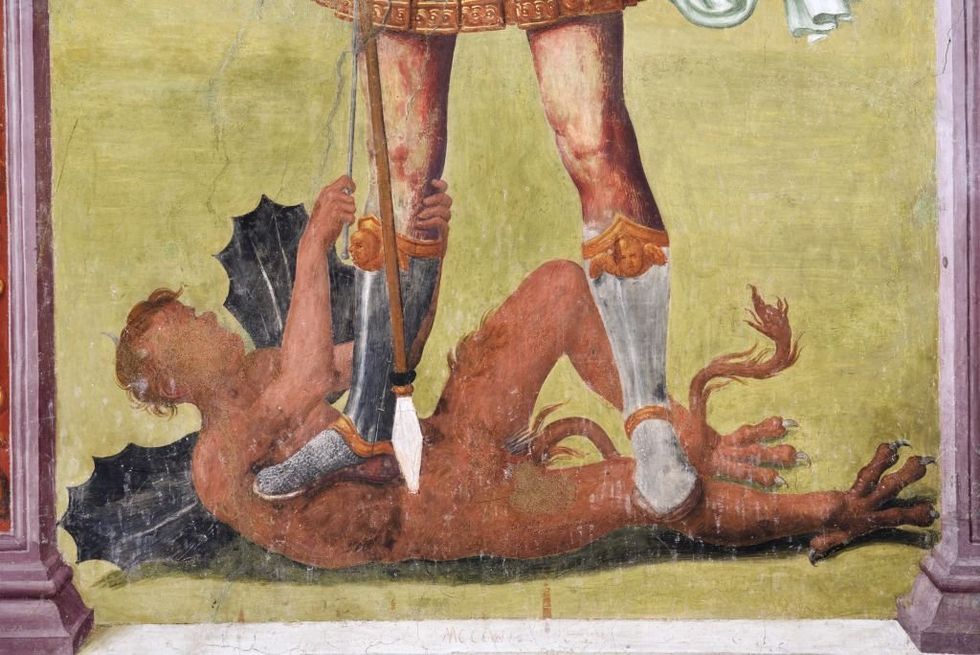
www.theblaze.com
Clinton labor secretary panics after Trump asks the archangel Michael for help fighting evil
President Donald Trump
posted a prayer to social media on Sunday, asking Saint Michael for help battling "the wickedness and snares of the Devil" — just days ahead of his return to Butler, Pennsylvania, where in July a Democratic donor shot him and killed the heroic patriarch of the Comperatore family.
The prayer and accompanying image of Saint Michael vanquishing Satan,
reposted by the Trump campaign, were largely well received. Michael is recognized as an archangel in Christianity, Judaism, and Islam, and the prayer simply asks for help routing evil.
However, a number of leftists reflexively expressed shock and horror, in some cases showcasing cultural and historical ignorance — just as
Ana Navarro of "The View" did when responding to Trump's happy birthday wishes to the Virgin Mary on the feast of her nativity earlier this month.
Former Clinton Labor Secretary and
Harris booster Robert Reich led the pack in ignoring or at the very least overlooking the fact that the post coincided with Michaelmas, the feast day of the archangels Michael, Gabriel, and Raphael, which is celebrated by Catholics — of which there are nearly 1.4 billion worldwide and at least 52 million stateside, including Trump's wife, Melania — as well as by Lutherans and Anglicans.
'By the power of God, cast into hell Satan.'
"Trump increasingly suggests that he is God's chosen instrument of wrath and that his opponents are 'evil spirits' to be 'cast into hell,'"
tweeted Reich, whose fellow Democrats helped set the stage for two known assassination attempts with incendiary rhetoric. "If you don't find this terrifying, you're not paying attention."
Reich, now a public policy professor at the University of California, Berkeley, apparently found this prayer terrifying:
Saint Michael the Archangel, defend us in battle. Be our defense against the wickedness and snares of the Devil. May God rebuke him, we humbly pray, and do thou, O Prince of the heavenly hosts, by the power of God, cast into hell Satan, and all the evil spirits, who prowl about the world seeking the ruin of souls. Amen.
The prayer was written by Pope Leo XIII following an Oct. 13, 1884, vision of demonic attacks on the church from within — and of the archangel tossing the offending demons back into the abyss.
It was long recited after Mass, though that obligation ended in 1965.
However, when discussing preparations for spiritual battle 13 years after he was wounded in an assassination attempt, Pope John Paul II
said, "Even though today this prayer is no longer recited at the end of the Eucharistic celebration, I invite everyone not to forget it, but to recite it to obtain help in the battle against the forces of darkness and against the spirit of this world."
According to the Diocese of Gary, Indiana, Pope Pius XI ordered the recitation of the prayer in 1929 for the conversion of Russia.
'But the sword / Of Michael from the Armorie of God / Was giv'n him temperd so, that neither keen / Nor solid might resist that edge.'
Saint Michael is one of the three angels mentioned by name in the scriptures and is regarded by multiple Christian denominations as the patron saint of the police, firemen, and members of the military. Michael is also the patron saint of numerous countries and cities, including Kyiv, Ukraine.
EWTN
indicated that Michael is referred to in two chapters of the Old Testament (in Daniel 10:13, 21 and 12:1) and in at least two books of the New Testament (Jude 1:9 and Revelation 12:7).
Revelation 12:7-9
states:
And there was war in heaven: Michael and his angels fought against the dragon; and the dragon fought and his angels, and prevailed not; neither was their place found any more in heaven. And the great dragon was cast out, that old serpent, called the Devil, and Satan, which deceiveth the whole world: he was cast out into the earth, and his angels were cast out with him.
The prayer Reich found terrifying not only has religious significance but engages a key character in the Western literary canon.
In Book Six of John Milton's "Paradise Lost," Saint Michael
introduces the proud and rebellious Lucifer to something called pain:
But the sword
Of Michael from the Armorie of God
Was giv'n him temperd so, that neither keen
Nor solid might resist that edge: it met
The sword of Satan with steep force to smite
Descending, and in half cut sheere, nor staid,
But with swift wheele reverse, deep entring shar'd
All his right side; then Satan first knew pain.
Robert Reich's concern-mongering post was not only slapped with a community note on X, highlighting some of this context, but ridiculed.
'You're totally delusional Robert.'
Auron MacIntyre, podcast host and columnist at Blaze Media, responded, "Any public expression of Christianity is now interpreted as a threat to our ruling order."
Conservative commentator Michael Knowles
noted, "Today is Michaelmas, which Christians have celebrated for ~1,500 years. This specific prayer, composed by Pope Leo XIII, was recited after every Low Mass in the world for 86 years. Religious and historical ignorance among our 'elite' is reaching record highs."
Seamus Coughlin of FreedomToons wrote, "Leo XIII: I will compose a prayer to scare the devil away[.] Marxist Professor: This prayer is terrifying."
"This is one of the most popular prayers in the Catholic faith and in no way suggests that Trump is saying he's God's 'chosen instrument of wrath,'"
tweeted conservative filmmaker Robby Starbuck. "You're totally delusional Robert."
Reich admitted in March that the lead-up to the election would test the "individual and collective capacities." In the months since, he appears to have found his limits on his blog, where he blamed Trump for the two apparent Democratic assassination attempts against him.
'We will FEAR NOT.'
Reich was not alone in expressing displeasure about Trump's prayer post.
New Atheist author James Lindsay
wrote that it's "a damn shame Trump has been pulled into this, probably on bad advice."
Claiming he grew up Catholic but had virtually no experience with Michaelmas, Lindsay suggested, "The Left will use it to characterize Trump as a religious warlord type, fitting the worst of the Operation Christian Nationalism motifs. Because of the Left/Right dialectic in play in the op, we'll all be forced to take a side or dip out into irrelevance."
Lindsay was similarly met with some notes indicating, again, projection might be at play.
While the posting of the prayer may have factored into a broader strategy to appeal to those American Catholics now
cluing into Kamala Harris' antagonism for their faith and beliefs, Trump appears to have adopted a more prayerful outlook since his brush with death on July 13.
"It was God alone who prevented the unthinkable from happening. We will FEAR NOT, but instead remain resilient in our Faith and Defiant in the face of Wickedness," he
wrote on July 14.
Like Blaze News? Bypass the censors, sign up for our newsletters, and get stories like this direct to your inbox. Sign up here!
















